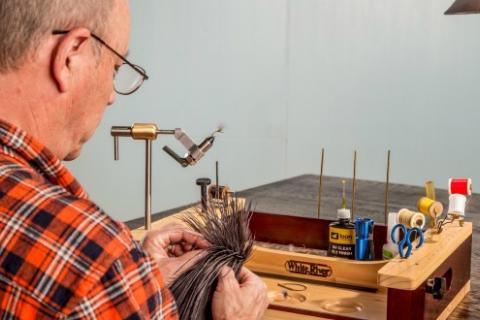
The arrival of ice on your favorite lakes and ponds does not mean that you should store away your fly box for the winter. Ice fishing tackle is inundated with tiny jigs in every shape and color imaginable—much like the flies in your box. The two are actually quite similar; with the exception that flies are often much better at mimicking the food sources gamefish target.
Out of all the different types of flies that you could use, scud patterns have been some of the most productive for me on the ice. If you have ever
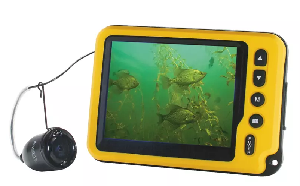 |
| Underwater cameras, like the Aqua-Vu Micro II, help to observe several types of scuds scurying about. |
dropped an underwater camera through your fishing hole and stirred up the bottom, you have probably observed several types of scuds scurrying about. There are a few varieties of nymphs that stay active all winter long and this is what anglers should attempt to imitate.
Scud patterns can work wonders in the right situation. Un-weighted scuds are great for targeting finicky fish, as they appear very natural in the water. They quiver when lightly jigged, giving them the appearance of a living, breathing, invertebrate. When fishing these un-weighted scud flies, lift them off the bottom and let them settle slowly back down. In most cases fish will grab them on drop.
You can also use scud patterns tied with beaded heads. These patterns will work a lot like leadheads and you can actively jig them to attract fish. It does not hurt to allow weighted scuds to hit the bottom once in a while, as the disturbance will help to draw in fish. Natural colors such as brown, olive and tan seem to work best, but if you happen onto an actively feeding school hot colors—like orange, yellow, or pink—can put fish on the ice fast.
It’s astounding the number of anglers that completely disregard flies for ice fishing. Scud patterns in particular will work wonders for Bluegills, Perch and Crappie. Take the time to try a few during your next hard-water fishing trip—you might be surprised at how productive they can be.
Scud Tying Steps
1. Start this fly by placing the hook into the vice and securing it in place tightly.
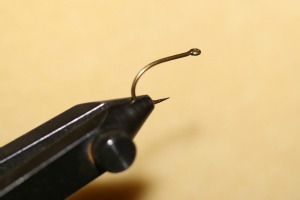
2. Place 8-10 turns of lead free weight on the hook shank just behind the hook eye working toward the back of the fly. Make sure to leave enough space to be able to form a nice small head for the fly.
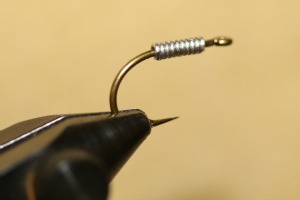
3. Attach the thread to the hook shank in front of the lead free weight and cover the wrapped weight lightly with thread to hold it in place.

4. Advance the thread to the back of the weight and tie in a 3 inch piece of monofilament. Wrap this monofilament down with thread until you reach the halfway point in the hook gape.
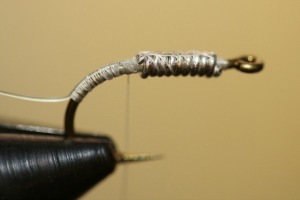
5. Cut a one-inch section of sili skin (remove the backing from the bottom ¼ inch) and wrap it down to the hook shank extending off the rear of the fly. You want to wrap this shellback halfway into the bend of the hook gape.

6. Pinch dub the thread with the gray dubbing and build a fat tapered body from the rear of the fly to just behind the hook eye.
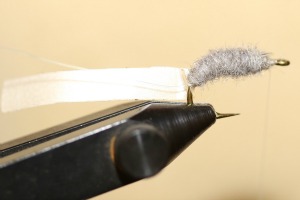
7. Once the body is built, pull the sili skin shellback over the body of the fly and tie it off behind the hook eye.
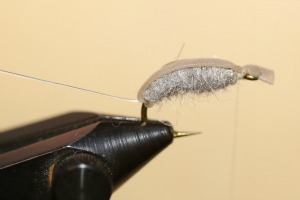
8. Wrap the monofilament forward up the body of the fly creating 4-7 segments for the body. Tie this monofilament off behind the eye and build a small neat head for the fly. Whip-finish the thread and cement the head thoroughly.
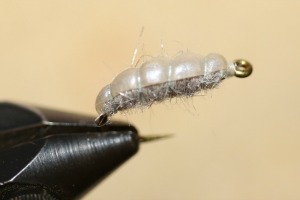
9. With a dubbing needle tease out the body of the fly (being careful not to catch the monofilament) creating the legs for your scud pattern. Tease both sides of the fly and clip any wild fibers that extend out sideways instead of down. Use your scissors to trim these dubbing fibers giving the fly an overall oval shape.
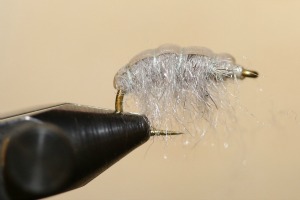
- 18779 views

